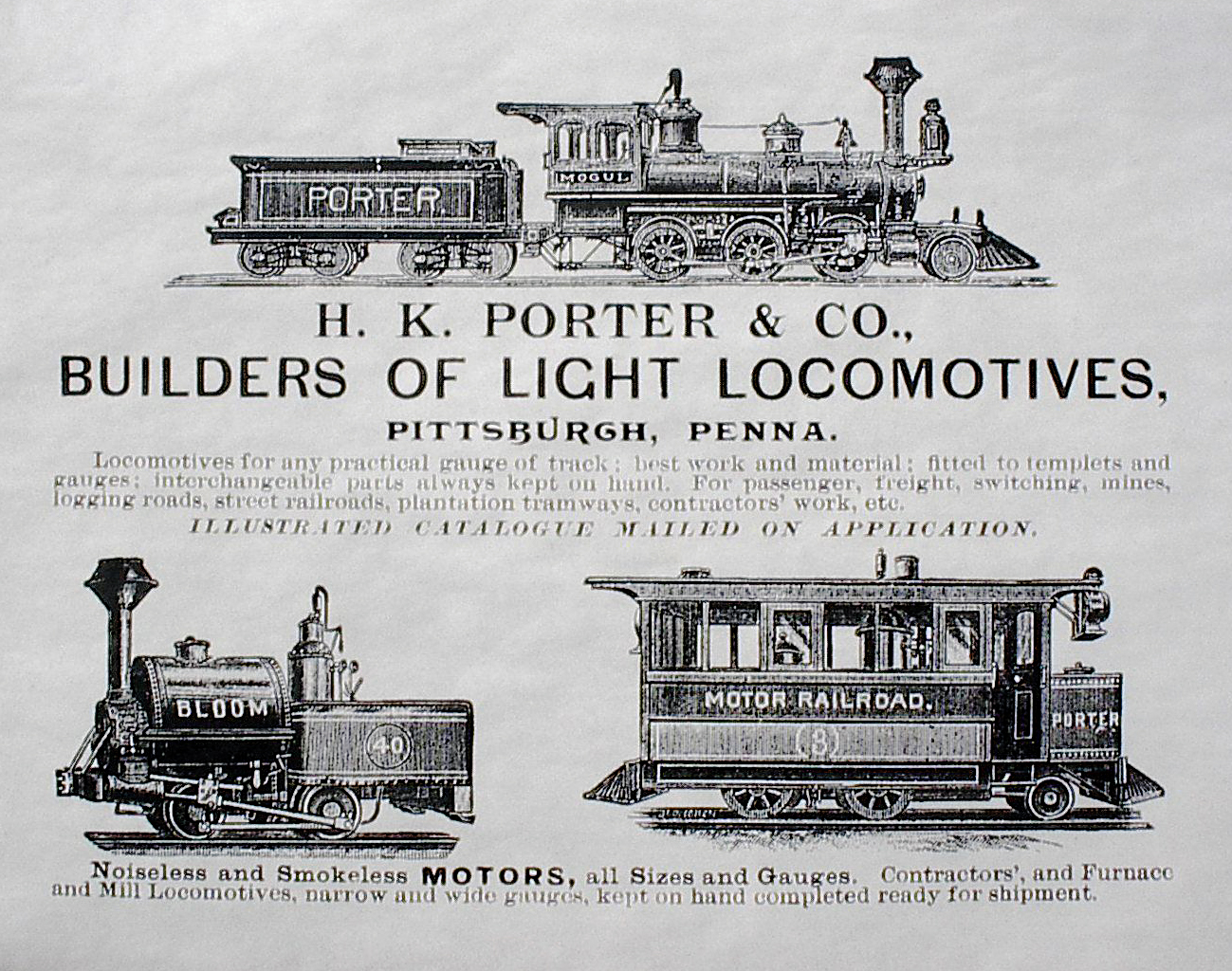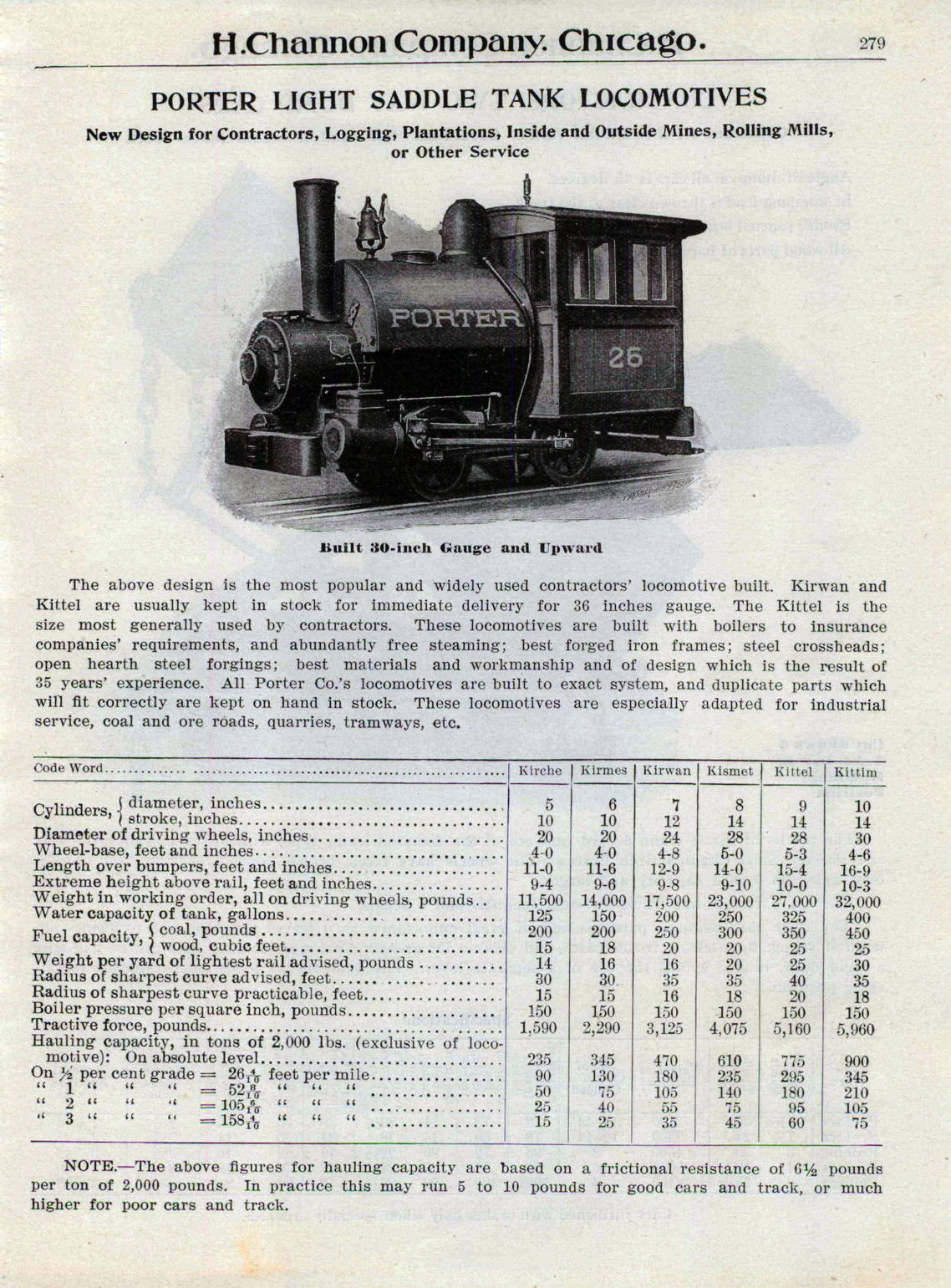H K Porter Company: Builder Of Small Steam Engines
Last revised: November 5, 2024
By: Adam Burns
One of the most successful builders of steam locomotives is perhaps the
least known, the H.K. Porter Company, which is partly due to the fact
that it typically did not market its models to the general railroad
industry.
After Porter began, just after the end of the Civil War, it produced more than 8,000 light duty and small steam switchers both domestically and overseas for all types of industrial applications, from mining operations to sugar plantations.
Most of its designs were quite small, such as the very popular 0-4-0T "dinky." After World War I the company slowly began to lose market share, especially in the 1930s with the coming of the diesel switcher. It never, truly dedicated itself to this new form of motive power and instead sold out after World War II.
Interestingly, today, the H.K. Porter name carries on under a new owner, which uses it as a means of marketing to sell various types of hand tools.
Additionally, dozens of Porter steam locomotives can be found in use around the country on tourist lines and railroad museums due to their relative inexpensive nature to restore and operate.
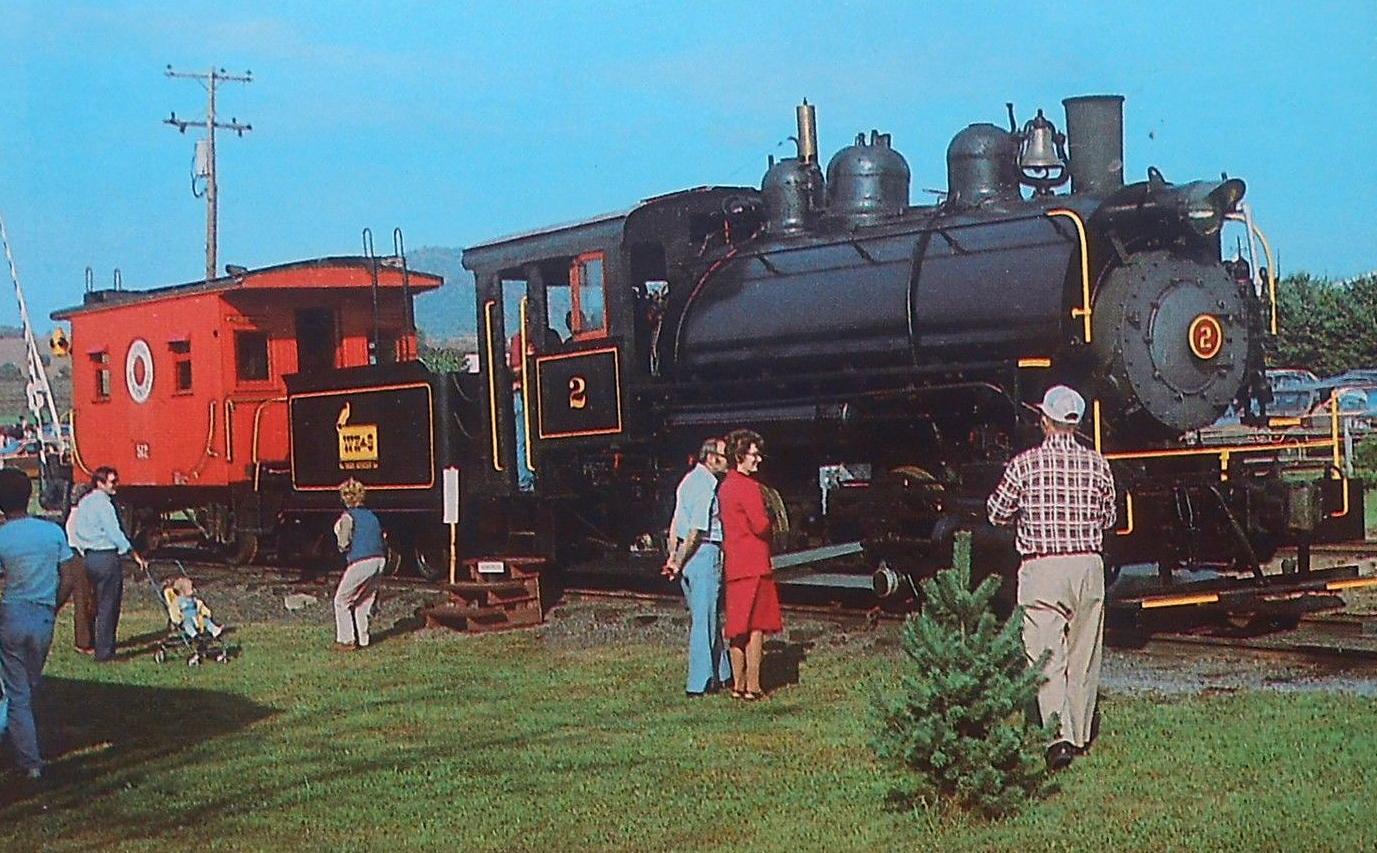 A postcard of Wanamaker Kempton & Southern 0-4-0ST #2 is seen her on display in Kempton, Pennsylvania on September 3, 1982. The locomotive was built for the railroad by H.K. Porter in 1920. John Hartman photo.
A postcard of Wanamaker Kempton & Southern 0-4-0ST #2 is seen her on display in Kempton, Pennsylvania on September 3, 1982. The locomotive was built for the railroad by H.K. Porter in 1920. John Hartman photo.The H.K. Porter Company dates back as Smith & Porter, founded in 1866 by partners Henry Porter and John Smith which opened a machine shop in Pittsburgh, Pennsylvania to repair and build a wide range of industrial equipment.
After just a year doing this type of work they received an order in 1867 for a small, industrial-sized steam locomotive by the New Castle Railroad & Mining Company of New Castle, Pennsylvania. In conjunction with a small Pittsburgh-based locomotive manufacturer, David Bell & Company, they came up with a 42-inch, narrow-gauge 0-4-0T design.
The success with this little steamer convinced the company to focus exclusively on building locomotives. In 1871 Porter merged with David Bell to form the Porter, Bell & Company while Smith left to form his own locomotive business, Smith & Dawson Locomotives (that became the National Locomotive Works).
Seven years later the organization was again renamed, as the H. K. Porter & Company and finally in 1899 as the H. K. Porter Company.
Prior to all of these company name changes and mergers, Porter spent the rest of the 19th century refining its product and along the way earned a reputation for building high quality, reliable, and rugged light duty locomotives (a trait that was stressed early on by Porter himself).
Since the company marketed its designs to small railroads and industries the 0-4-0T mentioned above or the 0-6-0T saddle tanks tended to be its best sellers.
Outwardly, Porter's locomotives became easily distinguished from other builders for a number of cosmetic touches applied to them including cylinders cast with the company name and the cab number painted within a small circle (unless otherwise noted).
Another significant reason that Porters became so popular, aside from their reliability, was in how the company marketed its product.
In many ways it was one of the first proponents of standardization offering replacement parts and stock locomotives, which were not customized like virtually all main line models.
This philosophy was decades ahead of its time and did not become popular within the general railroad industry until Electro-Motive showcased its new EA and FT diesel-electric locomotives in the mid/late-1930s.
As the H.K. Porter Company became more successful it began manufacturing larger, and even non-saddle tank designs such as 2-4-0s, 2-4-2s, 2-6-2 Prairies, and even 2-8-2 Mikados.
Even these larger wheel arrangements, however, were still primarily tailored to non-railroads such as lumber companies, brick and cement plants, power companies, and even various branches of the military.
Still, some common-carrier railroads did come to purchase Porter locomotives for secondary and yard duties like the Alaska Railroad. Interestingly, even a few streetcar lines used Porters!
In 1890 the company began marketing a compressed-air locomotive for use in coal mining operations. Instead of using traditional steam, compressed air held within two tanks situated where the boiler was usually located powered the pistons and rods.
The purpose of the design was to eliminate the burning of fuel to make steam, which was dangerous within a mine, as it could cause explosions due to the buildup of methane gas naturally released by coal.
The locomotive proved to be highly successful with more than 400 built (Porter would come to construct roughly 90% of them). The year 1899 also saw Porter reach its peak in terms of locomotives manufactured, more than 400 in a single year.
The prosperity occurring during these years led the company to open a new plant in Pittsburgh at that time as well.
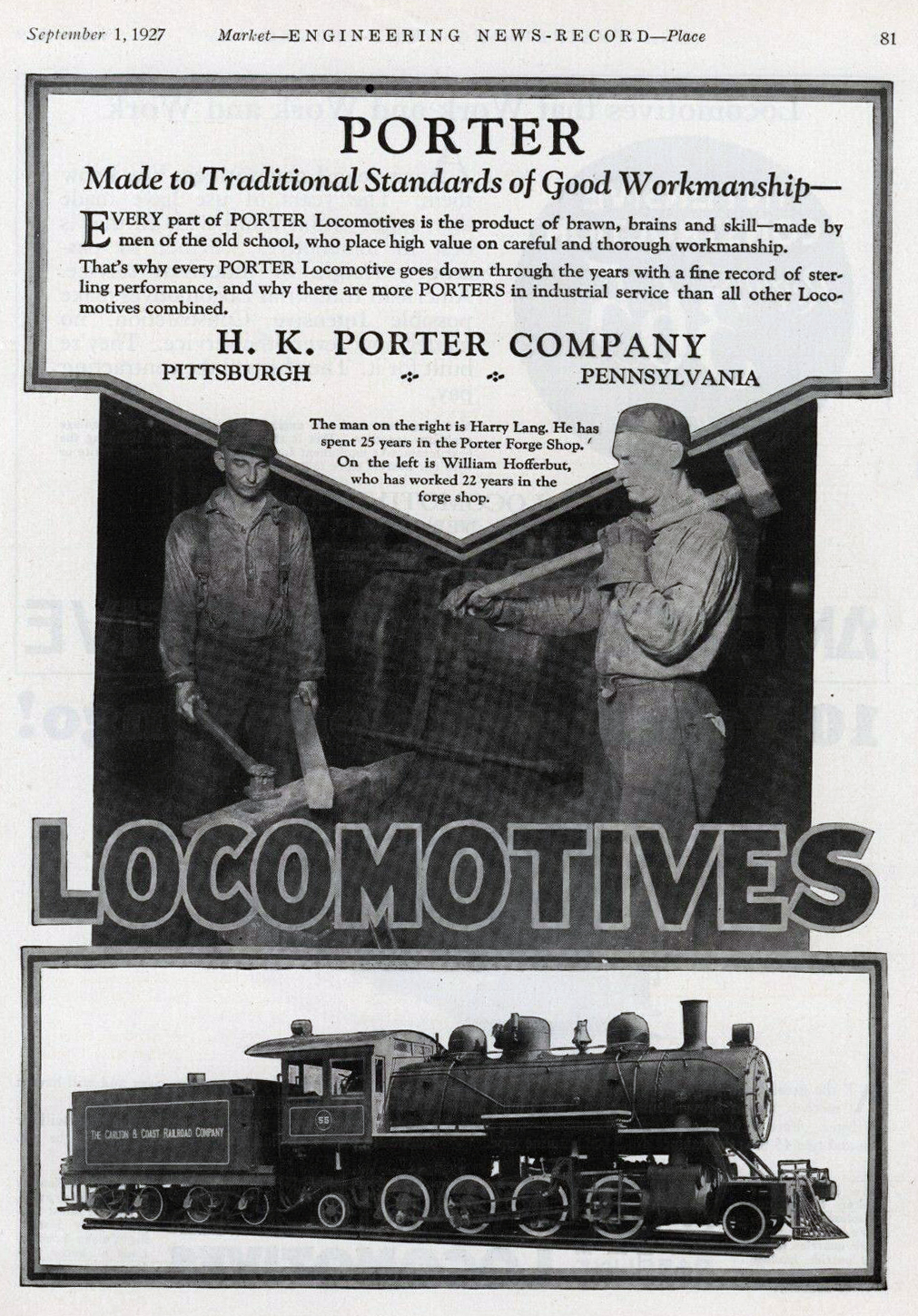 The H.K. Porter Company manufactured more than 7,800 locomotives at its plant in Pittsburgh's Lawrenceville neighborhood between 1867 and 1950. Its market was geared largely towards the industrial/military sector where it turned out thousands of switchers. Several are preserved across the country today.
The H.K. Porter Company manufactured more than 7,800 locomotives at its plant in Pittsburgh's Lawrenceville neighborhood between 1867 and 1950. Its market was geared largely towards the industrial/military sector where it turned out thousands of switchers. Several are preserved across the country today.The builder also patented another new, non-combustible design around 1911; known as the fireless locomotive it essentially used a pressurized cylinder of steam and hot water to power the pistons and rods.
Surprisingly, it turned out to be more reliable than earlier compressed-air design, which it ultimately replaced.
While Porter tested gasoline-powered locomotives as early as 1910 it never spent heavily in research and development, instead relying on its popular small, steam-powered designs. Like Whitcomb and Davenport,
Porter remained successful through World War I building small, narrow-gauge locomotives for the French trench railways. However, the company was in decline by the 1930s; its founder Henry Porter had died in 1921 and diesel switchers were becoming popular by that time.
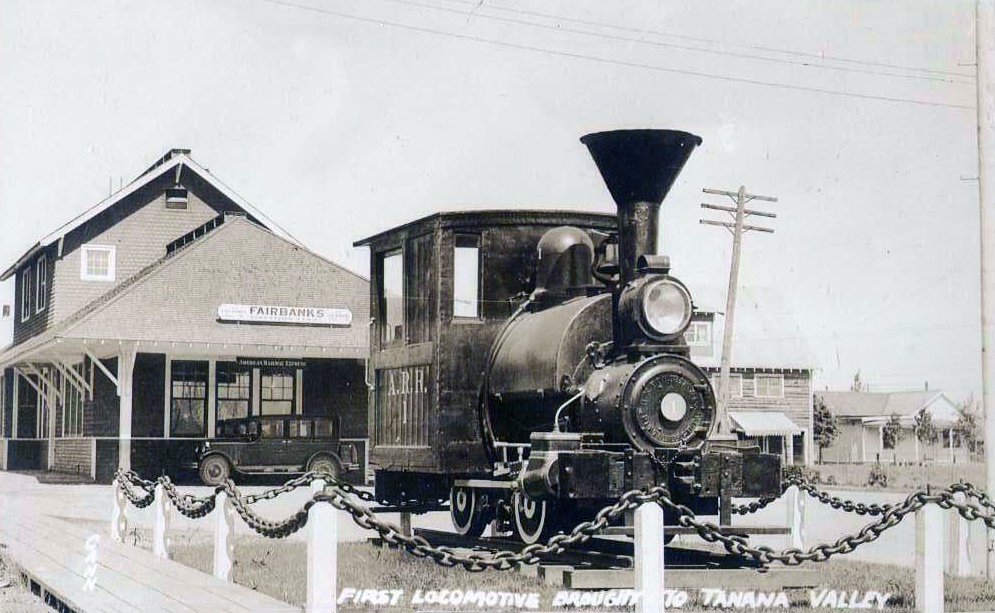 Alaska Railroad 0-4-0T #1 sits on display in Fairbanks, circa 1930's. The locomotive was built by H.K. Porter in 1899. Today, it is operational at the Tanana Valley Railroad in Pioneer Park, Fairbanks.
Alaska Railroad 0-4-0T #1 sits on display in Fairbanks, circa 1930's. The locomotive was built by H.K. Porter in 1899. Today, it is operational at the Tanana Valley Railroad in Pioneer Park, Fairbanks.Bankruptcy was declared in 1939 and the H.K. Porter Company was sold to Thomas Mellon Evans, who kept the name and hoped to revitalize the manufacturer.
Success returned with the start of World War II as Porter, along with its two rivals and Vulcan Iron Works, were asked to construct a USATC (United States Army Transportation Corps) S100 Class 0-6-0 for use in the African campaign, and later in Europe as the war progressed with more than 400 built in all.
The company's fortunes again turned for the worse following the war as demand for steam locomotives had virtually ended; all switcher-type models were now being built by the four major manufacturers of Baldwin/Lima, Electro-Motive, American Locomotive Company, and Fairbanks-Morse.
Recent Articles
-
Arizona's - Wine Tasting - Train Rides
Jan 14, 26 02:04 PM
For those who want to experience the charm of Arizona's wine scene while embracing the romance of rail travel, wine tasting train rides offer a memorable journey through the state's picturesque landsc… -
Arkansas's - Wine Tasting - Train Rides
Jan 14, 26 01:57 PM
This article takes you through the experience of wine tasting train rides in Arkansas, highlighting their offerings, routes, and the delightful blend of history, scenery, and flavor that makes them so… -
Tennessee ~ Murder Mystery ~ Dinner Train Rides
Jan 14, 26 01:42 PM
Amidst the rolling hills and scenic landscapes of Tennessee, an exhilarating and interactive experience awaits those with a taste for mystery and intrigue. -
California ~ Murder Mystery ~ Dinner Train Rides
Jan 14, 26 01:26 PM
When it comes to experiencing the allure of crime-solving sprinkled with delicious dining, California's murder mystery dinner train rides have carved a niche for themselves among both locals and touri… -
Illinois ~ Murder Mystery ~ Dinner Train Rides
Jan 14, 26 01:13 PM
Among Illinois's scenic train rides, one of the most unique and captivating experiences is the murder mystery excursion. -
Vermont's - Murder Mystery - Dinner Train Rides
Jan 14, 26 12:57 PM
There are currently murder mystery dinner trains offered in Vermont but until recently the Champlain Valley Dinner Train offered such a trip! -
Massachusetts Dinner Train Rides On Cape Cod!
Jan 14, 26 12:20 PM
The Cape Cod Central Railroad (CCCR) has carved out a special niche by pairing classic New England scenery with old-school hospitality, including some of the best-known dining train experiences in the… -
Maine Dinner Train Rides In Portland!
Jan 14, 26 11:31 AM
While this isn’t generally a “dinner train” railroad in the traditional sense—no multi-course meal served en route—Maine Narrow Gauge does offer several popular ride experiences where food and drink a… -
Kentucky Dinner Train Rides In Bardstown!
Jan 13, 26 01:14 PM
The essence of My Old Kentucky Dinner Train is part restaurant, part scenic excursion, and part living piece of Kentucky rail history. -
Kansas Dinner Train Rides In Abilene!
Jan 13, 26 12:44 PM
If you’re looking for a heritage railroad that feels authentically Kansas—equal parts prairie scenery, small-town history, and hands-on railroading—the Abilene & Smoky Valley Railroad (A&SV) delivers. -
Michigan ~ Murder Mystery ~ Dinner Train Rides
Jan 13, 26 11:24 AM
Among the lesser-known treasures of this state are the intriguing murder mystery dinner train rides—a perfect blend of suspense, dining, and scenic exploration. -
Virginia's - Murder Mystery - Dinner Train Rides
Jan 13, 26 11:11 AM
Among the state's railroad attractions, murder mystery dinner trains stand out as a captivating fusion of theatrical entertainment, fine dining, and scenic travel. -
Arizona Dinner Train Rides At The Grand Canyon!
Jan 13, 26 10:59 AM
While the Grand Canyon Railway does not offer a true, onboard dinner train experience it does offer several upscale options and off-train dining. -
Georgia Dinner Train Rides In Nashville!
Jan 13, 26 10:27 AM
If you’ve ever wished you could slow down, trade traffic for jointed rail, and let a small-town landscape roll by your window while a hot meal is served at your table, the Azalea Sprinter delivers tha… -
Indiana Valentine's Train Rides
Jan 12, 26 04:27 PM
If you’ve ever wished you could step into a time when passenger trains were a Saturday-night treat and a whistle echoing across farm fields meant “adventure,” the Nickel Plate Express delivers that fe… -
Ohio Valentine's Train Rides!
Jan 12, 26 04:20 PM
The Hocking Valley Scenic Railway offers one of the region’s most atmospheric ways to experience the Hocking Hills area: from the rhythmic click of jointed rail to the glow of vintage coaches rolling… -
Wisconsin's - Wine Tasting - Train Rides
Jan 12, 26 03:10 PM
Wisconsin might not be the first state that comes to mind when one thinks of wine, but this scenic region is increasingly gaining recognition for its unique offerings in viticulture. -
California's - Wine Tasting - Train Rides
Jan 12, 26 02:34 PM
This article explores the charm, routes, and offerings of these unique wine tasting trains that traverse California’s picturesque landscapes. -
Wisconsin Scenic Train Rides In North Freedom!
Jan 12, 26 02:20 PM
The Mid-Continent Railway Museum is a living-history museum built around the sights, sounds, and everyday rhythms of small-town and shortline railroading in the early 20th century, what the museum cal… -
Vermont Scenic Train Rides In Burlington!
Jan 12, 26 01:18 PM
Today, GMRC is best known by many travelers for its Burlington-based passenger experiences—most famously the Champlain Valley Dinner Train and the sleek, limited-capacity Cocktails on the Rails. -
Maryland's - Murder Mystery - Dinner Train Rides
Jan 12, 26 01:03 PM
Maryland is known for its scenic landscapes, historical landmarks, and vibrant culture, but did you know that it’s also home to some of the most thrilling murder mystery dinner trains? -
Minnesota's - Murder Mystery - Dinner Train Rides
Jan 12, 26 12:17 PM
Murder mystery dinner trains offer an enticing blend of suspense, culinary delight, and perpetual motion, where passengers become both detectives and dining companions on an unforgettable journey. -
Vermont Dinner Train Rides In Burlington!
Jan 12, 26 12:09 PM
There is one location in Vermont hosting a dedicated dinner train experience at the Green Mountain Railroad. -
Connecticut Dinner Train Rides In Essex!
Jan 12, 26 10:39 AM
Connecticut's rail heritage can be traced back to the industry's earliest days and a few organizations preserve this rich history by offering train rides. The Essex Steam Train also hosts dinner-theme… -
Florida Scenic Train Rides In Parrish!
Jan 11, 26 10:26 PM
The Florida Railroad Museum (FRRM) in Parrish offers something increasingly rare in today’s rail landscape: a chance to ride historic equipment over a surviving fragment of an early-20th-century mainl… -
California's - Wine Tasting - Train Rides
Jan 11, 26 02:28 PM
This article explores the charm, routes, and offerings of these unique wine tasting trains that traverse California’s picturesque landscapes. -
Georgia's - Murder Mystery - Dinner Train Rides
Jan 11, 26 02:07 PM
In the heart of the Peach State, a unique form of entertainment combines the thrill of a murder mystery with the charm of a historic train ride. -
Colorado ~ Murder Mystery ~ Dinner Train Rides
Jan 11, 26 01:43 PM
Nestled among the breathtaking vistas and rugged terrains of Colorado lies a unique fusion of theater, gastronomy, and travel—a murder mystery dinner train ride. -
Minnesota Dinner Train Rides In Duluth!
Jan 11, 26 01:32 PM
One of the best ways to feel the region's history in motion today is aboard the North Shore Scenic Railroad (NSSR), which operates out of Duluth’s historic depot. -
Illinois Dinner Train Rides At Monticello!
Jan 11, 26 12:42 PM
The Monticello Railway Museum (MRM) is one of those places that quietly does a lot: it preserves a sizable collection, maintains its own operating railroad, and—most importantly for visitors—puts hist… -
Alabama's - Wine Tasting - Train Rides
Jan 10, 26 09:29 AM
While the state might not be the first to come to mind when one thinks of wine or train travel, the unique concept of wine tasting trains adds a refreshing twist to the Alabama tourism scene. -
Maryland Dinner Train Rides At WMSR!
Jan 10, 26 09:13 AM
The Western Maryland Scenic Railroad (WMSR) has become one of the Mid-Atlantic’s signature heritage operations—equal parts mountain railroad, living museum, and “special-occasion” night out. -
Arkansas Dinner Train Rides On The A&M!
Jan 10, 26 09:11 AM
If you want a railroad experience that feels equal parts “working short line” and “time machine,” the Arkansas & Missouri Railroad (A&M) delivers in a way few modern operations can. -
South Dakota's - Murder Mystery - Dinner Train Rides
Jan 10, 26 09:08 AM
While the state currently does not offer any murder mystery dinner train rides, the popular "1880 Train" at the Black Hills Central recently hosted these popular trips! -
Wisconsin's - Murder Mystery - Dinner Train Rides
Jan 10, 26 09:07 AM
Whether you're a fan of mystery novels or simply relish a night of theatrical entertainment, Wisconsin's murder mystery dinner trains promise an unforgettable adventure. -
Missouri's - Murder Mystery - Dinner Train Rides
Jan 10, 26 09:05 AM
Missouri, with its rich history and scenic landscapes, is home to one location hosting these unique excursion experiences. -
Washington ~ Murder Mystery ~ Dinner Train Rides
Jan 10, 26 09:04 AM
This article delves into what makes murder mystery dinner train rides in Washington State such a captivating experience. -
Kentucky Scenic Train Rides At KRM!
Jan 09, 26 11:13 PM
Located in the small town of New Haven the Kentucky Railway Museum offers a combination of historic equipment and popular excursions. -
Washington "Wine Tasting" Train Rides
Jan 09, 26 08:53 PM
Here’s a detailed look at where and how to ride, what to expect, and practical tips to make the most of wine tasting by rail in Washington. -
Kentucky's - Wine Tasting - Train Rides
Jan 09, 26 08:21 PM
Kentucky, often celebrated for its rolling pastures, thoroughbred horses, and bourbon legacy, has been cultivating another gem in its storied landscapes; enjoying wine by rail. -
Kentucky's - Murder Mystery - Dinner Train Rides
Jan 09, 26 01:12 PM
In the realm of unique travel experiences, Kentucky offers an enchanting twist that entices both locals and tourists alike: murder mystery dinner train rides. -
Utah's - Murder Mystery - Dinner Train Rides
Jan 09, 26 01:05 PM
This article highlights the murder mystery dinner trains currently avaliable in the state of Utah! -
North Carolina Dinner Train Rides At NCTM!
Jan 09, 26 12:51 PM
Tucked into the Piedmont town of Spencer, the North Carolina Transportation Museum is the kind of place that feels less like a typical museum and more like a living rail yard that never quite stopped… -
Tennessee Dinner Train Rides At The TVRM!
Jan 09, 26 12:39 PM
Tucked into East Chattanooga, the Tennessee Valley Railroad Museum (TVRM) is less a “museum you walk through” and more a railroad you step aboard. -
New York Scenic Train Rides On The A&A!
Jan 09, 26 11:20 AM
The A&A is both a common-carrier short line moving freight and a heritage railroad hosting popular excursion trains, all on the same storied right-of-way. -
Pennsylvania Scenic Train Rides In Hollidaysburg!
Jan 09, 26 11:14 AM
Tucked into the Juniata River valley just south of Altoona, the Everett Railroad offers one of the most approachable—and photogenic—heritage-rail experiences in Pennsylvania -
Montana Dinner Train Rides Near Lewistown!
Jan 08, 26 03:03 PM
The Charlie Russell Chew Choo turns an ordinary rail trip into an evening event: scenery, storytelling, live entertainment, and a hearty dinner served as the train rumbles across trestles and into a t… -
Alabama's - Murder Mystery - Dinner Train Rides
Jan 08, 26 02:19 PM
There is currently one location in the state offering a murder mystery dinner experience, the Wales West Light Railway! -
Rhode Island's - Murder Mystery - Dinner Train Rides
Jan 08, 26 01:43 PM
Let's dive into the enigmatic world of murder mystery dinner train rides in Rhode Island, where each journey promises excitement, laughter, and a challenge for your inner detective. -
Florida's - Wine Tasting - Train Rides
Jan 08, 26 01:13 PM
Wine by train not only showcases the beauty of Florida's lesser-known regions but also celebrate the growing importance of local wineries and vineyards.

